
Search for history in Fox Hollow
SHENDANDOAH NATIONAL PARK, Va. — As you make your climb up on the Skyland Drive into Shenandoah National Park from the north entrance, you come across a land that is steeped in the sweat of generations past.
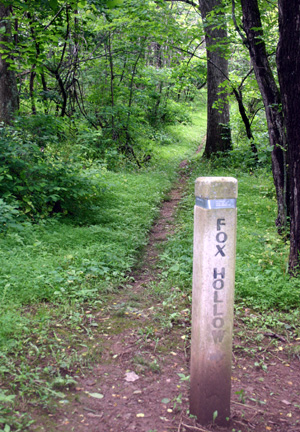 |
| A concrete marker notes the head of the Fox Hollow Trail (Photo by Tenille Lively). |
The Fox Hollow Trail is 4.6 miles into the park, directly across from the Dickey Ridge Visitor Center. It winds throughout the property of what was once the Fox Family farm, started by modest tenant farmer Thomas Fox in the early 19th century.
The trail dips into the hollow, a narrow and low spot between two ridges, and circles around for 1.2 miles in the 450-acre area that was once the farm though nature has taken the land back in the last 75 years, leaving only traces of the generations of Foxes that tilled the land.
“What were once open corn fields and grazing area has been naturally reforested since 1936 when the land came into the park,” said Warne Nelson, Dickey Ridge Visitor Center supervisor.
The trail is a self-guided tour that leads to the old homesite of the Fox family, along the way there are remnants of the old farm fences, a family cemetery, a millstone, and a spring box.
The trail takes about an hour to walk and is categorized at an easy difficulty level with an elevation drop and gain of 310 feet as you make your way into the hollow.
You begin the trail on a grassy plain at the top of Dickey Ridge, where the elevation is at 1,940 feet, you walk through the tall grass and reach the first trail post at the entrance of the light brush and new forestation. This first section of the trail is also the first half of the Dickey Ridge Trail, a fairly easy trail through overgrown fields and across a stream that continues for 2.7 miles.
 |
An old stone fence borders the Fox Hollow Trail (Photo by Tenille Lively). |
As you enter into the forest you hear a variety of birds and may come across hawks, with their broad wingspan if you have perceptive enough eyes. You follow along the trail the whole time talking notice of the light blue trail markers if you ever get confused as to which direction you should go in which are painted on the trees. Along the way there are many fallen branches, though these are regularly sawed off and cleared by the park rangers keeping up the maintenance of the trails.
It is important to have shoes with good traction, because while the trail is an easy hike, it is still a dirt and rock trail that can get muddy and slippery at points, especially if it has rained recently.
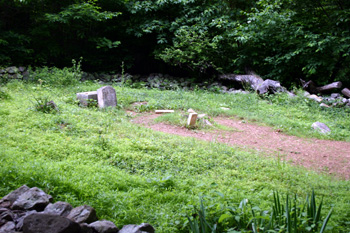 |
| The Fox family cemetery (Photo by Ross Whitsett). |
As the Dickey Ridge trail forks off, you continue down into Fox Hollow, along with the random birch, beech, and spruce trees among others, there is a thick layer of ferns and shrubs along the forest floor.
Small woodland creatures such as the gray squirrel and chipmunks may be seen scurrying through the brush.
Bug spray is also important, especially during the summer months, because the trail is thickly covered by the overhead trees and can be misty at times. One may come across various flies such as mosquitoes, the occasional spider and ticks, so it is important to protect yourself against being bitten.
As the trail winds downhill, you come across various sections of the farm wall, piled up rocks that were used to section off the pieces of the property. When you reach the bottom of the hollow you see the family cemetery in a clearing, fenced off with a small rock wall.
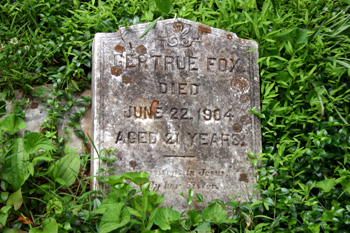 |
| A marker for one of the Fox family members who died in 1904 (Photo by Ross Whitsett). |
There are six stones remaining with four of them still standing. While the rock wall is mostly made out of the local greenstone, the burial markers are made of sandstone, which is much softer and makes for easier inscription and is less likely to get overgrown with moss.
Continuing on you see an old spring box as the trail curves around, made out of cement this was actually built by the park after the Foxes had left the land. It was formerly used as a water supply for the dining room in the Dickey Ridge Lodge, which is where the visitor center is currently.
There is a millstone hidden in the brush just a few yards down the trail, this is place before you get to the small stream. The curious aspect to this is that the stream clearly is too small to support a mill, so it is unknown why there is a millstone in the first place.
Crossing the stream that comes from the uphill on a small wooden bridge you see how wide the trail is at this point with a long rock wall along the south side. This part of the trail is what the old Fox Road was once that went all the way to Front Royal, about five miles away.
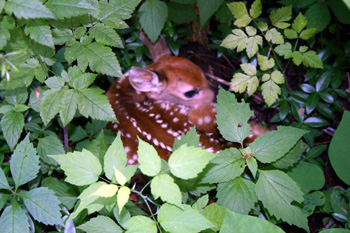 |
A fawn lies in the leaves just off the Fox Hollow Trail, no doubt waiting for its mother to return (Photo by Tenille Lively). |
Old trees that had been around during the Fox family days surround this park of the trail, including trees such as dogwoods, hickories, maples, sassafras, black gums and oaks. There is also an old Sycamore tree that Lemuel Fox was known to speak of and sit under to relax and reflect.
The trail ends with a sharp turn and a quick uphill jaunt. This leads back to the trail head and the grassy plain. When you exit the forest into the meadow there is a final trail marker, this signifies a beginning of the Snead Farm loop trail, a 1.4-mile side track that features an old apple orchard complex and barn that was incorporated into the park in the 1960s.
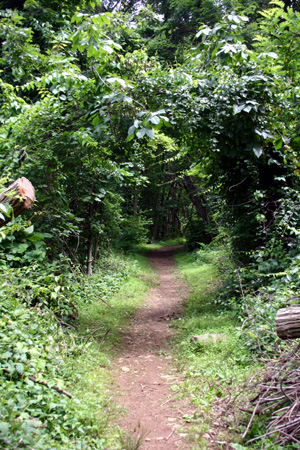 |
| The Fox Hollow Trail is often shaded by trees (Photo by Tenille Lively). |
Back in the 19th century, Thomas Fox became a tenant farmer on the land, with Marcus Buck as his landlord.
Buck had bought 2,000 acres in the beginning of the century on the Blue Ridge Mountains, he eventually sold half of it but kept the track of land around Front Royal.
Fox has 450 acres, 150 of which was cleared, and eventually accumulated the $5,000 he needed to buy the land from Buck.
Fox built a seven-room log house and cultivated his farm with corn, wheat rye, and oats and also raised horse, sheep and cattle which grazing in the bluegrass pasture.
When Thomas Fox died in 1879, the farm was left to his son Lemuel, whose grave is the centerpiece in the ruins of the old family cemetery.
To support the family, he sold timber and maintained 130 product acres, the whole family would chip in to keep the farm productive.
When the Shenandoah National Park was established in 1935 there were still 265 families still living there, but scores of other had already sold their land and moved beginning in 1926 when the park was first authorized.
Carolyn and Jack Reeder’s 1991 book Shenandoah Secrets: The Story of the Park’s Hidden Past provides a more in-depth history of the Fox family and other people who had lived in the Shenandoah Valley area.
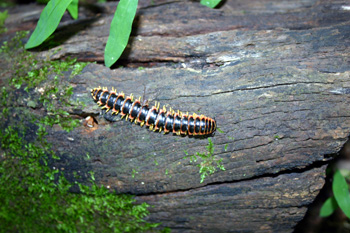 |
One of the park’s smallest creatures crawls along a fallen tree on the Fox Hollow Trail (Photo by Tenille Lively). |
“Primarily the trail attracts first time visitors, especially those from the Washington and Northern areas,” said Nelson.
This is mainly because the Fox Hollow Trail is the first hiking opportunity visitors pass by when entering from the north side and due to its easy difficulty rating for hiking, said Nelson.
While overall park visitation has been dropping for a long period, so far this year they have seen a moderate level of visitors, many of which interested in getting right into the woods for a quick stroll around the former Fox property, said Nelson.
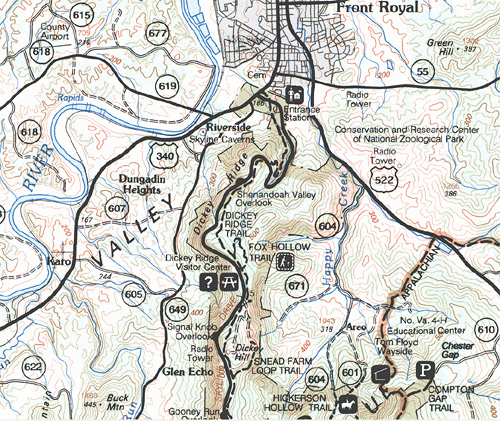 |
| Fox Hollow Trail is just south of the north entrance of Shenandoah National Park, near Front Royal, Va. The trailhead is at the Visitor Center at Dickey Ridge, just four miles south of the park entrance. |

Comments are Closed